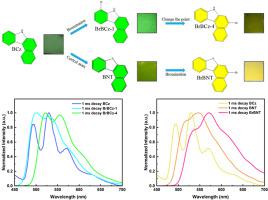当前位置:
X-MOL 学术
›
Dyes Pigments
›
论文详情
Our official English website, www.x-mol.net, welcomes your feedback! (Note: you will need to create a separate account there.)
Altering central atoms and bromination sites of phosphorescence units to control ultralong organic room temperature phosphorescence
Dyes and Pigments ( IF 4.5 ) Pub Date : 2024-05-01 , DOI: 10.1016/j.dyepig.2024.112186 Lin Han , Huiwen Jin , Lijuan Bu , Xue Zhang , Xiaohua Fu , Chen Qian , Zewei Li , Yan Guan , Mingxing Chen , Zhimin Ma , Zhiyong Ma
Dyes and Pigments ( IF 4.5 ) Pub Date : 2024-05-01 , DOI: 10.1016/j.dyepig.2024.112186 Lin Han , Huiwen Jin , Lijuan Bu , Xue Zhang , Xiaohua Fu , Chen Qian , Zewei Li , Yan Guan , Mingxing Chen , Zhimin Ma , Zhiyong Ma

|
We report two strategies to expand the library of , including altering the central atom and bromination. Directed by these two strategies, numerous new can be designed. Due to the limitation of organic synthesis and commercial availability, eight organic units (BCz, NBF, BNT, BrBCz-1, BrBCz-2, BrBCz-3, BrBCz-4 and BrBNT) were obtained to verify our proposed methods and study the impact of central atoms and bromination sites on organic room temperature phosphorescence. Considering BCz, NBF and BNT (Group Ⅰ) together, when the central atom is N or S, the room temperature phosphorescence is on as BCz and BNT have higher ISC (Intersystem Crossing) efficiency than NBF; from N to S, phosphorescence wavelength red shifts because the T energy level is closely related to the central atom and the lifetime shortens due to different ISC efficiency. Considering BCz, BrBCz-1, BrBCz-2 and BrBCz-3 (Group Ⅱ), bromination and different bromination sites on the benzene ring matters much to ISC efficiency but little to the intrinsic T energy level, leading to dramatical increase of phosphorescence intensity, sharp drop of phosphorescence lifetime and subtle change of phosphorescence wavelength (color). Considering BrBCz-4 and BrBNT (Group Ⅲ), bromination on the naphthalene moiety greatly affects both ISC efficiency and the intrinsic T energy level, resulting in dramatical increase of phosphorescence intensity, sharp drop of phosphorescence lifetime and significant red shift of phosphorescence color. Therefore, BNT, BrBCz-1, BrBCz-2, BrBCz-3, BrBCz-4 and BrBNT can be regarded as new while NBF cannot be. To our best knowledge, this work for the first time gives design suggestions of organic room temperature materials from the atomic level. This work may give a deep insight into organic phosphorescence from the perspective of and lay foundation for their future applications.
中文翻译:

改变磷光单元的中心原子和溴化位点来控制超长有机室温磷光
我们报告了两种扩展 库的策略,包括改变中心原子和溴化。在这两种策略的指导下,可以设计出许多新的产品。由于有机合成和商业可用性的限制,获得了八个有机单元(BCz、NBF、BNT、BrBCz-1、BrBCz-2、BrBCz-3、BrBCz-4和BrBNT)来验证我们提出的方法并研究其影响有机室温磷光的中心原子和溴化位点。综合考虑BCz、NBF和BNT(Ⅰ族),当中心原子为N或S时,BCz和BNT比NBF具有更高的ISC(系间窜越)效率,因此产生室温磷光;从N到S,磷光波长红移,因为T能级与中心原子密切相关,并且由于ISC效率不同而导致寿命缩短。考虑到BCz、BrBCz-1、BrBCz-2和BrBCz-3(第二组),苯环上的溴化和不同溴化位点对ISC效率影响很大,但对本征T能级影响不大,导致磷光强度急剧增加,磷光寿命急剧下降,磷光波长(颜色)发生细微变化。就BrBCz-4和BrBNT(Ⅲ族)而言,萘部分的溴化极大地影响了ISC效率和固有T能级,导致磷光强度急剧增加、磷光寿命急剧下降和磷光颜色显着红移。因此,BNT、BrBCz-1、BrBCz-2、BrBCz-3、BrBCz-4和BrBNT可以被视为新的,而NBF则不能。据我们所知,这项工作首次从原子水平给出了有机室温材料的设计建议。 这项工作可以从有机磷光的角度深入了解有机磷光,并为其未来的应用奠定基础。
更新日期:2024-05-01
中文翻译:

改变磷光单元的中心原子和溴化位点来控制超长有机室温磷光
我们报告了两种扩展 库的策略,包括改变中心原子和溴化。在这两种策略的指导下,可以设计出许多新的产品。由于有机合成和商业可用性的限制,获得了八个有机单元(BCz、NBF、BNT、BrBCz-1、BrBCz-2、BrBCz-3、BrBCz-4和BrBNT)来验证我们提出的方法并研究其影响有机室温磷光的中心原子和溴化位点。综合考虑BCz、NBF和BNT(Ⅰ族),当中心原子为N或S时,BCz和BNT比NBF具有更高的ISC(系间窜越)效率,因此产生室温磷光;从N到S,磷光波长红移,因为T能级与中心原子密切相关,并且由于ISC效率不同而导致寿命缩短。考虑到BCz、BrBCz-1、BrBCz-2和BrBCz-3(第二组),苯环上的溴化和不同溴化位点对ISC效率影响很大,但对本征T能级影响不大,导致磷光强度急剧增加,磷光寿命急剧下降,磷光波长(颜色)发生细微变化。就BrBCz-4和BrBNT(Ⅲ族)而言,萘部分的溴化极大地影响了ISC效率和固有T能级,导致磷光强度急剧增加、磷光寿命急剧下降和磷光颜色显着红移。因此,BNT、BrBCz-1、BrBCz-2、BrBCz-3、BrBCz-4和BrBNT可以被视为新的,而NBF则不能。据我们所知,这项工作首次从原子水平给出了有机室温材料的设计建议。 这项工作可以从有机磷光的角度深入了解有机磷光,并为其未来的应用奠定基础。






























 京公网安备 11010802027423号
京公网安备 11010802027423号